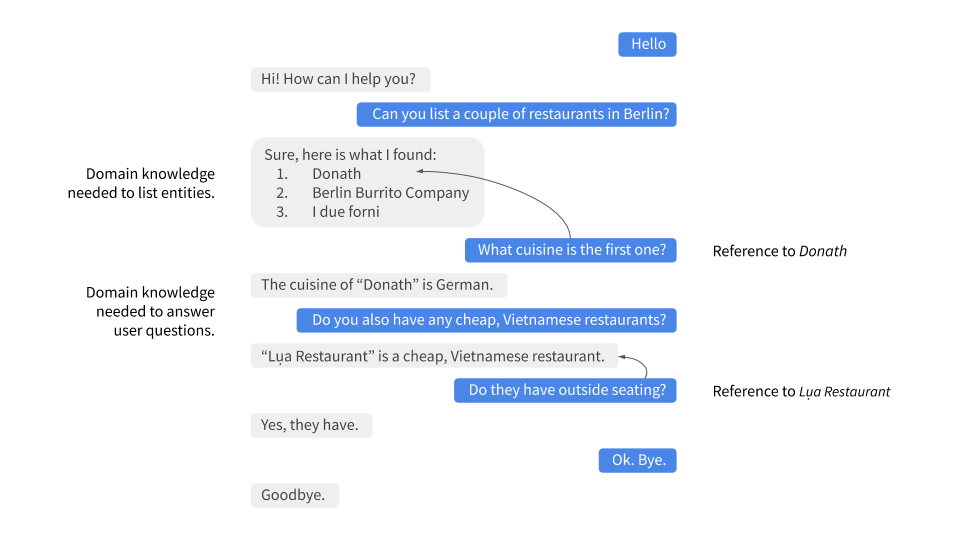知识库动作¶
在开源机器人框架 Rasa 中使用 ActionQueryKnowledgeBase 可以在对话中利用知识库中的信息。
警告
此功能是实验性的。我们通过社区反馈引入了这一实验性功能,因此鼓励大家进行尝试。但是,相关功在未来可能会发生变更或删除。如果有任何正面或负面反馈,可以在 Rasa 论坛上进行分享。
基于知识的的动作使你能够处理如下类型的对话:

对话式 AI 中的一个常见问题是,用户不仅通过名称来引用某些对象,而且还是用诸如“the first one”或“it”之类的引用术语。我们需要追踪提供的信息,将这些提及解析为正确的对象。
此外,用户可能希望在对话期间获得有关对象的详细信息,例如:餐厅是否有户外座位,或者它有多贵。为了响应这些用户请求,需要有关餐厅领域的知识。由于信息可能会发生变化,因此硬编码信息不是好的解决方案。
为了应对上述挑战,Rasa 可以与知识库集成。要使用此集成,可以创建一个从 ActionQueryKnowledgeBase 继承的自定义动作,这是一个预先编写的自定义动作,其中包含查询知识库中的对象及其属性的逻辑。
可以在 examples/knowledgebasebot(知识库机器人)中找到完整的示例,以及在下面实现此定义动作的说明。
使用 ActionQueryKnowledgeBase¶
创建一个知识库¶
用于回答用户请求的数据将存储在知识库中。知识库可用于存储复杂的数据结构。我们建议从使用 InMemoryKnowledgeBase 开始。一旦你想处理大量数据,可以切换到自定义知识库(请参见创建自己的知识库)。
要初始化 InMemoryKnowledgeBase,你需要在 JSON 文件中提供数据。如下示例包含有关餐馆和酒店的数据。JSON 结构应该包含每个对象类型的键,即 restaurant 和 hotel。每个对象类型都映射到一个对象列表,这里我们有一个包含 3 家餐厅的列表和一个包含 3 家酒店的列表。
{
"restaurant": [
{
"id": 0,
"name": "Donath",
"cuisine": "Italian",
"outside-seating": true,
"price-range": "mid-range"
},
{
"id": 1,
"name": "Berlin Burrito Company",
"cuisine": "Mexican",
"outside-seating": false,
"price-range": "cheap"
},
{
"id": 2,
"name": "I due forni",
"cuisine": "Italian",
"outside-seating": true,
"price-range": "mid-range"
}
],
"hotel": [
{
"id": 0,
"name": "Hilton",
"price-range": "expensive",
"breakfast-included": true,
"city": "Berlin",
"free-wifi": true,
"star-rating": 5,
"swimming-pool": true
},
{
"id": 1,
"name": "Hilton",
"price-range": "expensive",
"breakfast-included": true,
"city": "Frankfurt am Main",
"free-wifi": true,
"star-rating": 4,
"swimming-pool": false
},
{
"id": 2,
"name": "B&B",
"price-range": "mid-range",
"breakfast-included": false,
"city": "Berlin",
"free-wifi": false,
"star-rating": 1,
"swimming-pool": false
},
]
}
一旦在 JSON 文件(例如 data.json)中定义了数据,就可以使用该数据文件创建你的 InMemoryKnowledgeBase,该数据将被传递给查询知识库动作。
知识库中的每个对象都应至少具有 name 和 id 字段来使用默认实现。如果没有,你将不得不自定义你的 InMemoryKnowledgeBase。
定义 NLU 数据¶
在这个部分:
- 我们将引入一个新的意图
query_knowledge_base - 我们将标注
mention实体,以便模型检测到对象的间接提及,例如:“the first one” - 我们将广泛使用同义词
为了让对话机器人了解用户想要从知识库中检索信息,需要定义一个新意图。我们将其称为 query_knowledge_base。
我们可以将 ActionQueryKnowledgeBase 能够处理的请求分为两类:(1). 用户想要获取特定类型的对象列表;(2). 用户想要了解对象的某个属性。意图应该包含这两个请求的多种变体。
nlu:
- intent: query_knowledge_base
examples: |
- what [restaurants]{"entity": "object_type", "value": "restaurant"} can you recommend?
- list some [restaurants]{"entity": "object_type", "value": "restaurant"}
- can you name some [restaurants]{"entity": "object_type", "value": "restaurant"} please?
- can you show me some [restaurants]{"entity": "object_type", "value": "restaurant"} options
- list [German](cuisine) [restaurants]{"entity": "object_type", "value": "restaurant"}
- do you have any [mexican](cuisine) [restaurants]{"entity": "object_type", "value": "restaurant"}?
- do you know the [price range]{"entity": "attribute", "value": "price-range"} of [that one](mention)?
- what [cuisine](attribute) is [it](mention)?
- do you know what [cuisine](attribute) the [last one]{"entity": "mention", "value": "LAST"} has?
- does the [first one]{"entity": "mention", "value": "1"} have [outside seating]{"entity": "attribute", "value": "outside-seating"}?
- what is the [price range]{"entity": "attribute", "value": "price-range"} of [Berlin Burrito Company](restaurant)?
- what about [I due forni](restaurant)?
- can you tell me the [price range](attribute) of [that restaurant](mention)?
- what [cuisine](attribute) do [they](mention) have?
上述示例仅显示了与餐厅领域相关的示例。你应该将知识库中存在的每种对象类型的示例添加到相同的 query_knowledge_base 意图中。
除了为每种查询类型添加各种训练样本外,还需要在训练样本中指定和标注如下实体:
object_type:当训练样本从知识库中引用特定对象类型时,应该将对象类型标记为实体。使用同义词进行映射,例如restaurants到restaurant,将正确的对象类型列为知识库中的键。mention:如果用户通过“the first one”,“that one”或“it”来引用一个对象,你应该将这些术语标记为mention。还可以使用同义词将一些提及映射到符号。你可以在解决提及中了解这一点。attribute:知识库中定义的所有属性名称都应标识为 NLU 数据中的attribute。同样,使用同义词将属性名称的变体映射到知识库中使用的变体。
请记住将这些实体添加到你的领域文件中(作为实体和槽):
entities:
- object_type
- mention
- attribute
slots:
object_type:
type: any
influence_conversation: false
mappings:
- type: from_entity
entity: object_type
mention:
type: any
influence_conversation: false
mappings:
- type: from_entity
entity: mention
attribute:
type: any
influence_conversation: false
mappings:
- type: from_entity
entity: attribute
创建一个动作来查询知识库¶
要创建自己的知识库动作,需要继承 ActionQueryKnowledgeBase 并将知识库传递给 ActionQueryKnowledgeBase 的构造函数。
from rasa_sdk.knowledge_base.storage import InMemoryKnowledgeBase
from rasa_sdk.knowledge_base.actions import ActionQueryKnowledgeBase
class MyKnowledgeBaseAction(ActionQueryKnowledgeBase):
def __init__(self):
knowledge_base = InMemoryKnowledgeBase("data.json")
super().__init__(knowledge_base)
每当创建 ActionQueryKnowledgeBase 时,都需要将 KnowledgeBase 传递给构造函数。它可以是 InMemoryKnowledgeBase 或自己的 KnowledgeBase 实现(请参阅创建自己的知识库)。你只能从一个知识库中提取信息,因为不支持同时使用多个知识库。
这是此动作的全部代码。动作的名称为 action_query_knowledge_base,不要忘记将其添加到领域文件中:
注意
如果覆盖默认动作名称 action_query_knowledge_base,则需要将如下三个为特征化槽添加到领域文件中:knowledge_base_objects、knowledge_base_last_object 和 knowledge_base_last_object_type。这些槽由 ActionQueryKnowledgeBase 在内部使用。如果你保留默认动作名称,则会自动为你添加这些槽。
你还需要确保将故事添加到故事文件中,其中包括意图 query_knowledge_base 和动作 action_query_knowledge_base。例如:
stories:
- story: knowledge base happy path
steps:
- intent: greet
- action: utter_greet
- intent: query_knowledge_base
- action: action_query_knowledge_base
- intent: goodbye
- action: utter_goodbye
需要做的最后一件事是在领域文件中定义 utter_ask_rephrase 响应。如果该动作不知道如何处理用户的请求,它将使用此响应来要求用户重新措辞。例如,将如下响应添加到领域文件:
responses:
utter_ask_rephrase:
- text: "Sorry, I'm not sure I understand. Could you rephrase it?"
- text: "Could you please rephrase your message? I didn't quite get that."
添加所有相关部分后,该动作现在就可以查询数据库了。
如何工作¶
ActionQueryKnowledgeBase 会查看在请求中提取的实体以及之前设置的槽,来决定查询什么。
查询知识库中的对象¶
为了查询任何类型对象的知识库,用户的请求需要包含对象类型。如下为一个例子:
此问题包括感兴趣的对象类型:“restaurant”。机器人需要获取该实体来制定查询,否则该动作将不知道用户对哪些对象感兴趣。
当用户类似说:
用户想要获得:(1). 有意大利美食 (2). 位于柏林的餐馆列表。如果 NER 在用户的请求中检测到这些属性,则动作将使用这些属性来过滤在知识库中找到的餐馆。
为了让对话机器人检测到这些属性,你需要在 NLU 数据中将“Italian”和“Berlin”标记为实体”
intents:
- intent: query_knowledge_base
examples: |
- What [Italian](cuisine) [restaurant](object_type) options in [Berlin](city) do I have?.
属性名称“cuisine”和“city”应该与知识库中使用的名称相同。你还需要将它们作为实体和槽添加到领域文件中。
在知识库中查询对象属性¶
如果用户想要获取有关对象的特定信息,则请求应包括感兴趣的对象和属性。
3.6 版本新特性
用户不需要查询知识库来列入这之前的任何类型的对象。ActionQueryKnowledgeBase 将从用户的请求中提取对象类型,并在知识库中查询对象的属性。
例如,如果用户提出如下问题:
用户想要获得餐厅“Berlin Burrito Company”(感兴趣的对象)的“cuisine”(感兴趣的属性)。
应将感兴趣的属性和对象标记为 NLU 训练数据中的实体:
intents:
- intent: query_knowledge_base
examples: |
- What is the [cuisine](attribute) of [Berlin Burrito Company](restaurant)?
确保将对象类型“restaurant”作为实体和槽添加到领域文件中。这将支持 ActionQueryKnowledgeBase 提取用户感兴趣的对象的对象类型。
解析提及¶
按照上述示例,用户可能并不总是用他们的名字来指代餐馆。用户可以通过名称来引用感兴趣的对象,例如“Berlin Burrito Company”(对象的表示字符串),或者他们可能通过提及引用先前列出的对象,例如:
我们的动作能够将这些提及解析为知识库中的实际对象。更具体的说,它可以解析两种提及类型:(1). 序数提及,例如:“the first one”;(2). 例如“it”或“that one”的提及。
序数提及¶
当用户通过它在列表中的位置来引用一个对象时,它被称为序数提及。如下为一个示例:
用户:What restaurants in Berlin do you know?
对话机器人:Found the following objects of type 'restaurant': 1: I due forni 2: PastaBar 3: Berlin Burrito Company
用户:Does the first one have outside seating?
用户使用“the first one”一词来指代“I due forni”。其他序数提及可能包括“the second one”,“the last one”,“any”或“3”。
当向用户呈现对象列表时,通常使用序数提及。为了将这些提及解析为实际对象,我们使用在 KnowledgeBase 类中设置的序数提及映射。默认映射如下所示:
{
"1": lambda l: l[0],
"2": lambda l: l[1],
"3": lambda l: l[2],
"4": lambda l: l[3],
"5": lambda l: l[4],
"6": lambda l: l[5],
"7": lambda l: l[6],
"8": lambda l: l[7],
"9": lambda l: l[8],
"10": lambda l: l[9],
"ANY": lambda l: random.choice(l),
"LAST": lambda l: l[-1],
}
序数提及映射将字符串(例如“1”)映射到列表中的对象,例如 lambda l: l[0] 表示索引为 0 的对象。
例如,由于序数提及映射不包含“the first one”条目,因此使用实体同义词将 NLU 数据中的“the first one”映射到“1”很重要:
intents:
- intent: query_knowledge_base
examples: |
- Does the [first one]{entity: "mention", value": 1} have [outside seating]{entity: "attribute", value": "outside-seating"}
NER 将“first one”检测为提及实体,但将“1”放入提及槽。因此,我们的动作可以将提及槽与序数提及映射一起使用,来将“first one”解析为实际对象“I due forni”。
你可以通过在知识库实现上调用 set_ordinal_mention_mapping() 函数来覆盖序数提及映射(请参阅自定义 InMemoryKnowledgeBase)。
其他提及¶
查看如下对话:
用户:What is the cuisine of PastaBar?
对话机器人:PastaBar has an Italian cuisine.
用户:Does it have wifi?
对话机器人:Yes.
用户:Can you give me an address?
在“Does it have wifi?”的问题中,用户通过“it”这个词来指代“PastaBar”。如果 NER 检测到“it”作为实体提及,知识库操作会将其解析为对话中最后提到的对象“PastaBar”。
在下一个输入中,用户间接引用对象“PastaBar”,而不是明确提及它。知识库动作将检测用户想要获取特定属性的值,在本例中为地址。如果 NER 未检测到提及或对象,则该动作假定用户指的是最近提及的对象“PastaBar”。
你可以通过在初始化动作时将 use_last_object_mention 设置为 False 来禁用此行为。
自定义¶
自定义 ActionQueryKnowledgeBase¶
如果你想自定义对话机器人对用户说的内容,可以覆盖 ActionQueryKnowledgeBase 的如下两个函数:
utter_objects()utter_attribute_value()
当用户请求对象列表时使用 utter_objects()。一旦对话机器人从知识库中检索到对象,它将默认使用一条消息响应用户,格式如下:
Found the following objects of type 'restaurant': 1: I due forni 2: PastaBar 3: Berlin Burrito Company
或者如果没有找到对象:
如果你想更改话语格式,可以在动作中覆盖 utter_objects() 方法。
函数 utter_attribute_value() 确定当用户询问有关对象的特定信息时对话机器人会说什么。
如果在知识库中找到感兴趣的属性,对话机器人将用如下话语进行响应:
如果没有找到所请求属性的值,对话机器人将响应:
如果要更改对话机器人话语,可以覆盖 utter_attribute_value() 方法。
注意
博客上有一个关于如何在自定义动作中使用知识库的教程。本教程详细解释了 ActionQueryKnowledgeBase 背后的实现。
创建自己的知识库动作¶
ActionQueryKnowledgeBase 应允许你轻松开始将知识库集成到你的动作中,但是,该动作只能处理两种用户请求:
- 用户想要从知识库中获取对象列表
- 用户想要获取特定对象的属性值
该动作无法比较对象或考虑知识库中对象之间的关系。此外,在对话中解析对最后提到的对象的任何提及可能并不总是最佳的。
如果你想处理更复杂的用力,可以编写自己的自定义动作。我们在 rasa_sdk.knowledge_base.utils(代码)中添加了一些帮助函数来帮助你实现自己的解决方案。我们建议使用 KnowledgeBase 接口以便你仍可以将 ActionQueryKnowledgeBase 与新的自定义动作一起使用。
如果你编写了解决上述用例之一或新用例的知识库动作,请务必在论坛上告诉我们。
自定义 InMemoryKnowledgeBase¶
InMemoryKnowledgeBase 类继承 KnowledgeBase。你可以通过覆盖如下函数来自定义 InMemoryKnowledgeBase:
get_key_attribute_of_object():为了追踪用户上次谈论的对象,我们将键属性的值存储在特定的槽中。每个对象都应该有一个唯一的键属性,类似于关系数据库中的主键。默认情况下,每个对象类型的键属性名称都设置为id。你可以通过调用set_key_attribute_of_object()覆盖特定对象类型的键属性的名称。-
get_representation_function_of_object():让我们关注如下餐厅:{ "id": 0, "name": "Donath", "cuisine": "Italian", "outside-seating": true, "price-range": "mid-range" }当用户要求对话机器人列出所有意大利餐厅时,它不需要餐厅的所有详细信息。相反,你希望提供一个有意义的名称来标识餐厅,在大多数情况下,对象的名称就可以。函数
get_representation_function_of_object()返回一个将上述餐厅对象映射到其名称的 lambda 函数。每当对话机器人谈论特定对象时,都会使用此方法,以便为用户提供一个有意义的对象名称。
默认情况下,lambda 函数返回对象的
name属性的值。如果你的对象没有name属性,或者对象的name不明确,则应通过调用set_representation_function_of_object()为该对象设置一个新的 lambda 函数。{ "1": lambda l: l[0], "2": lambda l: l[1], "3": lambda l: l[2], "4": lambda l: l[3], "5": lambda l: l[4], "6": lambda l: l[5], "7": lambda l: l[6], "8": lambda l: l[7], "9": lambda l: l[8], "10": lambda l: l[9], "ANY": lambda l: random.choice(l), "LAST": lambda l: l[-1], }你可以通过调用
set_ordinal_mention_mapping()函数来覆盖它。如果你想了解有关如何使用此映射的更多信息,请参见解析提及。
有关使用 set_representation_function_of_object() 方法覆盖对象类型“hotel”的默认表示的 InMemoryKnowledgeBase 的示例实现,请参见示例对话机器人。InMemoryKnowledgeBase 本身的实现可以在 rasa-sdk 包中找到。
创建自己的知识库¶
如果你有更多数据,或者如果你想使用更复杂的数据结构,例如涉及不同对象之间的关系,可以创建自己的知识库实现。只要继承 KnowledgeBase 并实现 get_objects()、get_object() 和 get_attributes_of_object() 方法。知识库代码提供了有关这些方法应该做什么的更多信息。
你还可以通过调整自定义 InMemoryKnowledgeBase 部分中提到的方法来进一步自定义你的知识库。
注意
我们写了一篇博客来解释如何建立自己的知识库。